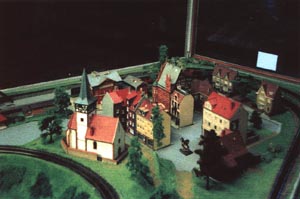"Blockism" is a colloquial
term used in hip-hop culture to describe belonging to a house,
a block, or another specific place: to a micro world. At Sparwasser
HQ, from May 3rd to June 8th 2002, thirteen artists
from the academy in Odense, Denmark, explore clashes and similarities
(mutual influences) between different "blocks."
"Blocks" are bricks in the wall of society and are
perceived often, despite their interconnectedness with other
"blocks"/structures in the dominant social system,
as static, closed structures. Increasingly, the sense of being
bound to a specific place is dissolving and opportunities for
culture to cross borders are emerging. Increased movement between
urban areas, in particular, produces new potentials for exchange
between various "blocks." One positive consequence
of cultural exchange is the possibility for emancipation. The
influx of new influences brings into question the validity of
defining one's identity according to categories such as nationality,
gender, class, race, and culture.
On the other hand, nationalism and cultural protectionism are
the negative effects of a backlash against contemporary cultural
influx. This tendency is seen in several countries whose
governments are moving toward the political-right. The recent
political situation in Denmark, and in a large part of Europe,
does not support the development of fluid cross-cultural movement.
Berlin can be seen as a paradigm for the interaction - political,
cultural, religious, and economic - between eastern and western,
northern and southern cultures. Within this context, the present
exhibition, BLOCKISM, questions whether culture is a stable
entity.
The artists presented in BLOCKISM share a common background
as students at the art academy in Odense. Exhibiting in Berlin,
in a broader context, these artists explore firsthand the fluidity
of the boundaries between "blocks." A new space for
discussing issues of identity and belonging emerges.
JESSE J.M. JENSEN's installation, "A Void,"
explores critically the development and trappings of identity,
by mimicking the structures of a small, local community in Denmark.
"My Danish Collection" by SVEND-ALLAN SØRENSEN
asks whether it is possible to expose national belonging through
musical preference. In proverbs translated from Danish to German,
TINA SCHERZBERG plays with the transference of meaning between
languages. Identity as cultural phenomenon is also the theme
of the alternative models of German Meissner porcelain created
by LOUISE SPARRE. In IDUN VARVIN's video installation,
a Turkish man is portrayed poetically through the sayings and
images of his environment. JAKOB ØRSTED's film
stills, "Buddy Movies," dealing with intimate
physical relations between men, examine the concept of "homo
sociality" and the creation of identity.
ANDERS PETERSSON explores Berlin from a Scandinavian perspective
in his photos, shot on location in Berlin. ANDERS H. NISSEN
works also with themes of alienation and inclusion in local places.
In the installation "1:87," Nissen shows how
an unfamiliar size can be adopted in another society. NERMIN
DURAKOVIC maps the asylum centers of Denmark. These centers
present themselves, in the local language, thus not spoken by
their foreign clients, as ideal holiday places. The photo "Nunu"
by CASPER MAARE tells about the exclusion of the individual
in society. Similarly, LINE T. KRISTENSEN's installation
reveals the division between the self and others. CHORINNE
CHAMBARD is French and lives in Berlin. In her self-portraits,
"I am you," she wears German uniforms. HENRIK
B. KNUDSEN, playing with the poem ME/WE, shows that
one cannot rely on one's surroundings for validation. In the
sound installation by JACOB BORGES, a battle takes place
between a German and a Danish DJ. The sounds mix with the other
artworks, crossing and blocking national belonging.
Thanks to Christine Wolfe for helping with the english translation.
